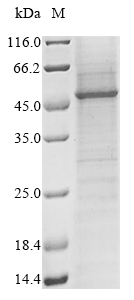This recombinant HumanKCNN4 protein is an in vitro E.coli (cell-free) expressed Full Length protein. Its purity is 85%+ determined by SDS-PAGE. Cell-free protein expression is the in vitro synthesis of a protein using translation-compatible extracts of whole cells. In principle, whole-cell extracts contain all the macromolecules and components needed for transcription, translation, and even post-translational modification. These components include RNA polymerase, regulatory protein factors, transcription factors, ribosomes, and tRNA. When supplemented with cofactors, nucleotides, and the specific gene template, these extracts can synthesize proteins of interest in a few hours.
The KCNN4 is the encoding gene for the KCa3.1/SK4, which plays a critical role in calcium-activated anion secretion in mice and humans. It is abundantly expressed in non-excitable cells such as erythrocytes, lymphocytes, and placenta cells. The KCa3.1 has been found to participate in the pacemaker activity of cardiomyocytes sourcing from human embryonic stem cells (hESC-CMs). It is involved in cancer progression, including cell proliferation, apoptosis, epithelial-mesenchymal transition (EMT), and metastasis.






